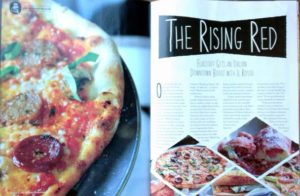![]() March/April 2015
March/April 2015
Story & Photography by Gail G. Collins
 On a recent foodie tour through New York City with our son, who works in the restaurant industry, we wandered into Mario Batali’s Eataly. The conglomeration of corner shops under one roof, if you will—from pasta and sweets to fish and meats—contains hundreds of thousands of imported Italian products. While putting a damper on eating local, such a display does invoke a yearning for tomato sauce. In fact, the celebrity chef believes making red sauce should be the first lesson of every kitchen novice. And yes, his recipe employs canned tomatoes. Shocking, I know. “It’s simple, it’s delicious … it almost hurts,” Batali summed in the introduction.
On a recent foodie tour through New York City with our son, who works in the restaurant industry, we wandered into Mario Batali’s Eataly. The conglomeration of corner shops under one roof, if you will—from pasta and sweets to fish and meats—contains hundreds of thousands of imported Italian products. While putting a damper on eating local, such a display does invoke a yearning for tomato sauce. In fact, the celebrity chef believes making red sauce should be the first lesson of every kitchen novice. And yes, his recipe employs canned tomatoes. Shocking, I know. “It’s simple, it’s delicious … it almost hurts,” Batali summed in the introduction.
What is it about eating humble, Italian-American fare that so satisfies it makes us sigh and put our neighborhood eatery on speed dial? Even for those of us who didn’t have a nonna, biting into the perfect pizza pie evokes images of a rustic kitchen with sauce bubbling. Or at least a desire for adoption into a longstanding Italian immigrant family, where there is always room at the table for one more. Beginning in 1890, Italian families entered America through New York City for the first time and, to many a mama’s credit, the restaurant business.
Classic, quality ingredients utilized in time-tested recipes is the answer to the venerable success of pizza joints, sub shops and endless pasta plates. Bob Verderame of Il Rosso Italiane, a modest spot which opened in downtown in 2014, cooks two massive pots of sauce over a flame for several hours every day. “You can taste every little thing in the sauce,” he said, proffering a spoon of what he calls “red gravy.” It’s his grandmother’s recipe, tweaked, he admitted.
Verderame had always wanted to open a restaurant. Maybe, it was the fact that his first job was in an Italian restaurant and his second in a pizzeria. He explained it this way, “These are the foods I knew from New Jersey, and I provide what I craved for others. It’s good anywhere—homemade with the best, fresh ingredients.” He learned his skills from Palermo Sicilians, who worked tirelessly. Verderame had cooked for huge family groups his whole life, so at 50 years old, he took in the town of Flagstaff. Il Rosso is a big draw for East Coast transplants.
Daughter-in-law, Tiffany Spyra, keeps the place running smoothly, and as a red-haired gal, is part of the restaurant’s namesake. A steady stream of customers pushed through the doors of the homey place for lunch on a weekday. The antipasto contains meat, cheese and pickled veg, shopped daily. The sandwiches star Village Baker with an extra step for perfected bread. In fact, there are seven steps to the ideal sandwich—Verderame is serious about this. The cheese and meat is Boarshead, hand-sliced thick. “Their flavors are intense, hearty and linger on the tongue,” he said.
The calzones and strombolis come as the menu lists—no substitutions. The folded pies are filled with prosciutto or sausage and veg, plus fluffy ricotta, made on the premises. They’re not behemoths, but a handhold, cooked in a decades-old cast-iron skillet. Verderame had to re-program locals to squared, whole-milk mozzarella slices and limited combinations. “I don’t do a supreme-ingredient pizza, but I do supreme pizza ingredients.” It’s a traditional kitchen run by a Jersey punk rocker. The pizza is baked on stone for a crisp, charred crust that isn’t soggy or burned. Double-aught Caputo flour, the gold standard, allows gluten-free clients access to the pies.
The chicken parmigiana sandwich features breaded, juicy chicken on grilled bread with the ideal portion of red sauce to moisten, but not soak, it. Hearty, not bready. Il Rosso offers dining until 3 a.m. and does a bang-up business then selling fries with red gravy. With plenty of parking, it’s easy to cruise by for a meal or take-out. There are plenty of local brews to wash it down and a short list of dependable wines, plus a regular change-up of shots, such as limoncello, to keep it fun and simple.
With only one table still available at Il Rosso, folks entered, who were originally from upstate New York and New Jersey. The man outlined his expectations, recounting tomato pie (pizza) he’d savored back East and eagerly ordered. Maybe, the intrinsic thing with Italian-American cuisine is the memory it conjures up. Even if you’ve never eaten somewhere before, the fork goes in the mouth, the eyes close, and we’re transported to that place and food we craved. Molto bene, Nonna.
NAMLM Gail G. Collins
